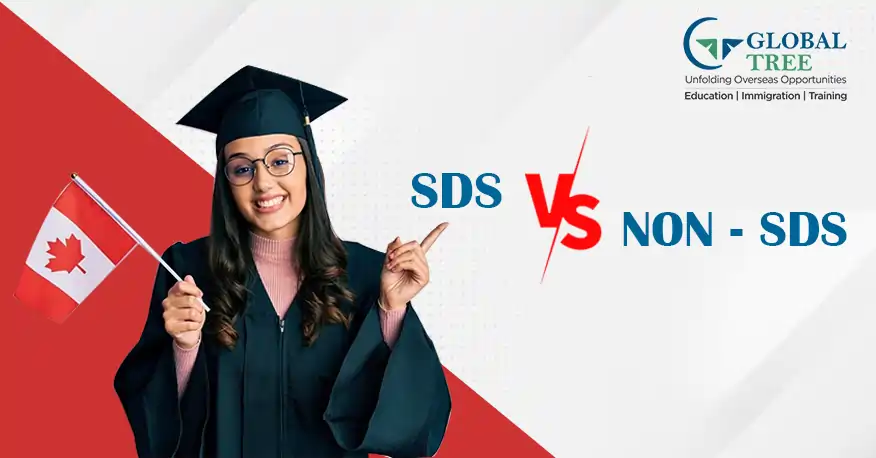Difference Between SDS and Non-SDS

- Introduction
- New IELTS Requirements for Canada SDS
- What is SDS?
- What is Non-SDS?
- SDS vs. Non SDS
- SDS Document Requirements for Visa Application
- Non-SDS Document Requirements for Visa Application
- Why Choose SDS over Non-SDS?
- What is the application Process for SDS?
- What is the application Process for Non-SDS?
- List of SDS Colleges in Canada
- What is the Success Rates of Both Categories?
- FAQs
Introduction
If you are aspiring to study in Canada, you might have come across the terms SDS and Non-SDS during the visa application process. SDS refers to Student Direct Stream, also called ad Students Partner Program, and is open to few countries like India, Brazil, etc. Non-SDS is generally used for visa application process for temporary residence regarding work or study purposes. It is open to people from different countries irrespective of the place they come from. In this blog, we will help you understand the main differences between SDS and Non-SDS.
New IELTS Requirements for Canada SDS
According to IRCC, the changes in IELTS requirements for Canada SDS will start on August 10, 2023.
IELTS test takers under SDS program must achieve an overall 6.0 bands in order to get accepted.
The modifications in the IELTS are intended to provide best possibilities and opportunities to international students to complete their studies in Canada.
What is SDS?
The Student Direct Stream (SDS) is known as the Students Partner Program (SPP). Canada immigration services have taken this as an initiative to provide the best possibilities for international people. Under SDS program, student visa applications are processed quickly if they want to complete their studies in Canada. However, SDS application can be submitted through an online medium. Also, students must meet certain eligibility requirements set up by IRCC for SDS program.
What is Non-SDS?
Non-SDS is for students who are unable to meet the SDS requirements while applying for Canada visa. It is a used to apply for a visa application to study in Canada. The requirements will also differ and more documents may be required.
SDS vs. Non SDS
SDS is express-entry visa application which is used to fasten the visa process whereas Non-SDS is used by everyone for immigration purposes regarding work or education. This is basic difference between SDS and Non-SDS visa applications. In addition, Non-SDS is applicable to all countries across the world, whereas SDS is limited to certain countries like China, India, Peru, and others.
SDS Document Requirements for Visa Application
- Candidates must have their original academic transcripts and must have scored at least 55% aggregate marks in under-graduation.
- The applicants must have a minimum of 50% or above in under-graduation to pursue post-graduation courses.
- Statement of Purpose( Let it be well-defined and structured)
- Scores of English language test like IELTS-6.0 for UG and an overall band of 6.5 for PG.
- Acceptance letter from the colleges falling under SDS category.
- Candidates must carry a Guaranteed Investment Certificate
- 3 Digital Photographs of the applicant
- Receipt of the tuition fees paid
- Certificates of medical tests
- Visa application fees - (INR 11K approx.)
Non-SDS Document Requirements for Visa Application
- Candidates must have their original academic transcripts and must have scored at least 55% aggregate marks in under-graduation.
- The applicants must have a minimum of 50% or above in under-graduation to pursue post-graduation courses.
- Scores of English language test like IELTS-6.0 for UG and an overall band of 6.5 for PG.
- Offer or acceptance letter from the colleges under Non-SDS.
- Certificates or Proof of previous work experience. Payslips of the last 3 months is also required.
- Financial proofs that cover bank savings, student loans, investments, etc.
- Income tax return documents of the candidate or the sponsor
- Tuition fees receipt
- Certificates of medical tests
- Visa application fees - (INR 11K approx.)
(Read More: How to migrate to Canada without IELTS score?)
Why Choose SDS over Non-SDS?
We hope that you have understood the difference between SDS and Non-SDS. There are few reasons why SDS is chosen over Non-SDS for visa applications.
Less Documentation: Under SDS category, visa application requires few documents only. Candidates need not submit many documents to provide financial eligibility. Whereas under the category of Non-SDS approach, the number of documents required are more.
Fast Process: SDS approach is direct and streamlined. It is also simple as compared to Non-SDS.
What is the application Process for SDS?
To get your study permit faster, you must apply online under SDS category. There is no paper application for Student Direct Stream. Make sure to collect all the documents before applying for visa. Below is the checklist:
- Instruction guide for the application form
- Scanned digital copies of supporting documents
- Valid credit card for the payment
- Give the biometrics and visit the official website. Answer the asked questions and pay the biometric fee.
What is the application Process for Non-SDS?
Step1: Visit the CIC Canada website and log in using the GC Key user ID and password. Accept the terms and conditions for the application to start. Then, fill in the identification validation.
Step 2: Enter the personal reference code. If code is not available, determine the eligibility by answering few questions and applying online. Finally save and exit.
Step 3: After completing all the questions, a pop-up will appear on the website that conveys if you are eligible or not. If qualified, you can follow the next step.
Step 4: Review and recheck with all your answers!
Step 5: Check your documents and personal checklist. Do add the necessary if you missed out on any.
Step 6: Submit the application.
List of SDS Colleges in Canada
Many Colleges in Canada have their own Designated Learning Number (DLN) that makes the institution as a part of the SDS program. The top colleges in Canada under SDS category are:
- Sheridan College Institute of Technology & Advanced Learning
- George Brown College
- Humber College Institute of Technology & Advanced Learning
- Red River College of Applied Arts, Science & Technology
- Niagara College
- Parkland College
- Fleming College
- Loyalist College of Applied Arts & Technology
- Canadore College
- Vancouver Island University
- Northern Lights College
- Columbia International College
- Lakeland College
- Northern Alberta Institute of Technology
- Lasalle College
- Seneca College of Applied Arts & Technology
- Sault College
- Northern College
- Mohawk College of Applied Arts & Technology
- Lawrence College
- Dawson College
- Alberta Bible College
- Seneca College of Applied Arts & Technology
- Niagara College
- Loyalist College of Applied Arts & Technology
- Lambton College of Applied Arts & Technology
- Georgian College of Arts & Technology
- Fanshawe College of Applied Arts & Technology
- Durham College
- Confederation College of Applied Arts & Technology
- Conestoga College
- Clair College of Applied Arts & Technology
- Centennial College of Applied Arts & Technology
- Canadore College -North Bay, Ontario
- Cambrian College of Applied Arts & Technology
- Algonquin College
- Camosun College
- College of New Caledonia
- College of the Rockies
- Columbia International College
- Douglas College
- Kwantlen Polytechnic University
- Langara College
- North Island College
- Northern Lights College
- Okanagan College
- Selkirk College
- University of the Fraser Valley
- Vancouver Community College
- Vancouver Island University
- Bow Valley College, Calgary
- Lakeland College
- Medicine Hat College
- Norquest College
- Northern Alberta Institute of Technology
- Assiniboine Community College
- Manitoba Institute of Trades and Technology, Winnipeg
- Red River College of Applied Arts, Science & Technology
- Parkland College
- Saskatchewan Polytechnic
- Lasalle College
What is the Success Rates of Both Categories?
The success rate for SDS applications is higher than the non-SDS applications. This is due to the underlying fact that SDS has fewer documents than in non-SDS. According to the IRCC statistics, success rate for SDS candidates was 71% in 2021 and 40% for non-SDS applicants.
(Read More: How much money is required to migrate to Canada?)
FAQs
- Which is better when compared between SDS and Non-SDS?
The processing of files is faster in SDS when compared to Non-SDS. You must also show some funds while filling out the visa application.
- Is GIC compulsory for Non-SDS?
A Guaranteed Investment certificate is not compulsory for the Non-SDS category.
- What is the role of SOP for the SDS category?
You will receive your visa under the SDS category even if you apply without it. But if you are not confident about it, attach one.
- How long does the SDS visa take?
The visa processing may take 2-3 months. In the SDS category, international students might take 4-6 weeks for the visa.









